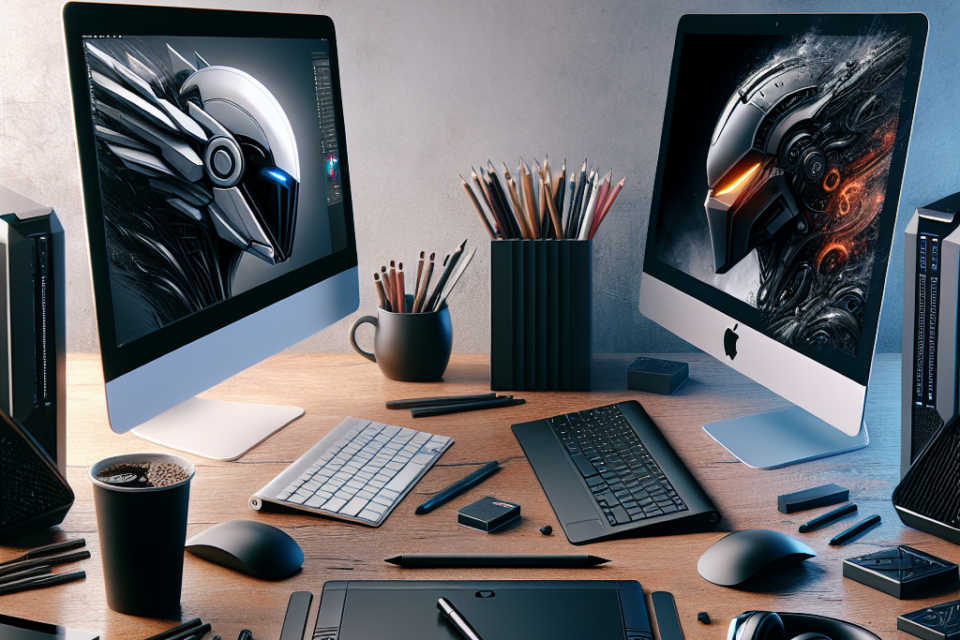Mac vs. PC: Which Is Better for Creatives?

Performance
When it comes to performance, both Mac and PC offer high-end models capable of handling demanding creative tasks. Macs, particularly those with Apple’s M1 chip, are renowned for their outstanding performance in video editing, graphic design, and music production. The M1 chip provides exceptional speed and efficiency, which is a significant advantage for creatives who handle resource-intensive applications.
On the other hand, PCs, especially those equipped with powerful Intel or AMD processors, can be customized to meet specific performance needs. This flexibility allows creative professionals to choose components such as the GPU, RAM, and storage options that best fit their workflows. In terms of raw performance, top-tier PCs can match or exceed Mac capabilities, but the key difference lies in the level of customization available.
Design
Design is a critical factor for many creatives, and Apple has built a reputation for its sleek and minimalist aesthetics. Macs are often praised for their premium build quality, intuitive design, and cohesive ecosystem. The Retina display, found in many Mac models, offers exceptional color accuracy and clarity, which is crucial for tasks like photo and video editing.
While PCs offer a wide range of designs from various manufacturers, they may lack the uniformity and polish of Apple’s offerings. However, certain high-end PC models also feature impressive displays and innovative designs tailored to creatives. Brands like Microsoft, with their Surface line, provide high-resolution touchscreen displays and versatile form factors that can appeal to artists and designers.
Software
Software availability is another essential consideration. Macs come pre-loaded with a host of creative applications such as GarageBand, iMovie, and Photos, which are highly integrated with macOS. Additionally, professional software suites like Final Cut Pro, Logic Pro X, and Affinity Designer are macOS-exclusive and optimized specifically for Mac hardware.
On the other hand, PCs excel in software compatibility. Windows-based systems support a broader range of applications, including industry-standard tools like Adobe Creative Cloud, Autodesk, and Avid. While most of these software programs are available for both platforms, certain niche applications may only run on Windows. Furthermore, the gaming industry heavily favors PCs, offering superior performance and a wider selection of high-quality games, which can be a bonus for creatives who game in their spare time.
Cost
Cost is often a decisive factor in the Mac vs. PC debate. Generally, Macs come with a higher upfront cost, attributed to their premium build and integrated ecosystem. While this higher initial investment can be justified by their durability and consistent performance, it can be a barrier for young or budget-conscious creatives.
Conversely, PCs provide a broader range of price points and configurations, from budget-friendly options to high-end machines. This flexibility allows creatives to pick a setup that suits their financial constraints without compromising on essential features. Additionally, the ability to upgrade components over time can extend the lifespan and efficiency of a PC, offering long-term value for professionals who prefer gradual investments.
User Experience
User experience also plays a significant role. macOS is known for its stability, intuitive interface, and seamless integration with other Apple devices. For creatives who rely heavily on their smartphones, tablets, and laptops working in harmony, the Apple ecosystem provides a streamlined and efficient experience.
Windows has made considerable strides in user experience with features like the Windows Ink Workspace for digital artists and the Windows Subsystem for Linux (WSL) for developers. Moreover, the variety of hardware options allows users to find or build a PC that perfectly matches their ergonomic and functional needs, enhancing overall user satisfaction.
Conclusion
The choice between Mac and PC ultimately depends on individual preferences, specific creative needs, and budget constraints. Macs offer a cohesive, high-quality experience with exceptional performance and design, making them a solid choice for those who value an integrated ecosystem and are willing to invest in it. PCs, on the other hand, provide unparalleled flexibility, customization options, and a wider range of software compatibility at various price points. By evaluating these factors, creatives can determine which platform aligns best with their workflow and personal preferences.
